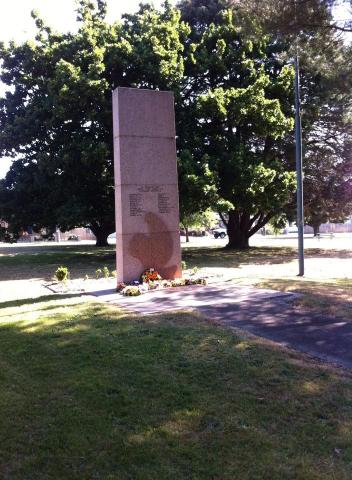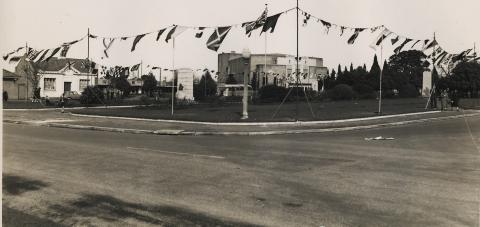ANDOR MESZAROS AND THE YALLOURN CENOTAPH
In April 1953 ‘The Argus’ newspaper carried the following report about the day that the Governor of Victoria Sir Dallas Brooks officially unveiled the new Cenotaph in the gardens of Yallourn…
GOVERNOR UNVEILS YALLOURN WAR MEMORIAL
“Two thousand people packed Yallourn's town square yesterday to watch Sir Dallas Brooks, Governor, unveil the town's war memorial. In the crowd were members of the R.S.L., C.M.F., and the S.E.C.'s own 99th Construction Squadron, and Scouts, Guides and Brownies. The £1,800 memorial, a Cenotaph, was started two years ago after it had been decided on by a local plebiscite.” ‘The Argus’13th April, 1953.
In an historic event, visiting dignitaries gathered with the townspeople of Yallourn to witness the unveiling of a striking piece of stone work and to pause and remember those men and women who had died on active service. It is believed that the idea for such a War Memorial had been advanced at a meeting of the Yallourn Branch of the RSL some five years earlier. In his address that day, Sir Dallas Brooks said…
“The Memorial would provide a suitable centre for the laying of wreaths on occasions when the Fallen were commemorated.”
The fifteen-foot high Cenotaph was constructed of red granite which had been excavated at Murray Bridge in South Australia. The article in ‘The Morwell Advertiser’ described the monument as…
“…a simple Grecian column depicting on its front face the figure of a kneeling woman placing a wreath on the stone of remembrance and typifying sorrowing motherhood.” April 5th 1953.
Members of the Yallourn RSL lined the pathway to the Cenotaph and the Governor inspected a Military Guard of Honour on his arrival at the Town Square gardens. It is known that the Yallourn Orchestral & Choral Society, together with the Yallourn Combined Churches Choir, offered a rendition of ‘The Recessional.’ The Yallourn Band and a local Caledonian Pipe Band also performed during the ceremony.
Local identities who formed part of the official party that day included: - Brigadier John Field (Superintendent), Mr E Hunt (SECV), Mr H Stoddard (MLA), Mr J Galbally (State Minister), Mrs W Graham (Girl Guides Association) and Mr D Bavinton (Scouts). Lady Brooks met and spoke with local representatives of the Scouts, Cubs, Guides and Brownies prior to the commencement of the formalities.
In his speech, Sir Dallas Brooks thanked the Yallourn War Memorial committee members Captain D Robertson, Cr A Fewster, Cr W Wallace and Mr D Sambell. He also praised the work carried out by the SEC architects (Mr W Gower & Mr W Eales) and the brilliance of sculptor Andor Meszaros.
The moving ceremony concluded with the sounding of the ‘Last Post’ and ‘Reveille’ which were played by the members of the Royal Melbourne Regiment.
ANDOR MESZAROS, THE SCULPTOR OF THE YALLOURN CENOTAPH
The Cenotaph in the Town Square (later to be known as Monash Square) was designed and carved by Andor Meszaros. The story of Andor’s life in Hungary and his arrival in Australia makes absorbing research and his significant contribution to Yallourn and its people should be placed on record.
Andor Meszaros was born in Budapest in 1900. Andor’s father, Sandor (Alexander) was a solicitor. His mother, Bertha, had a lasting influence on his life as she was a skilled sculptress. Andor studied as a building engineer (architect) in Vienna and then broke his course to study sculpture at the Academy Julian in Paris in 1924-5. He finished his course in Vienna in 1927 and returned to Budapest to work as an employed architect. He established his own practice as an architect in 1932. Andor married Elizabeth in 1932.
One of the inspirations of Andor’s life in Europe was the well-known Hungarian sculptor and graphic artist, Josef Csaky. It is also recorded that Andor met Pablo Picasso during this period. Andor began to study medallic sculpture in Budapest under Hungary’s best medallic artist, Ede Telcs and also collaborated with Telcs on major sculpture projects. It was here that he learned many of the skills which enabled him to live as a sculptor in Australia.
With the war clouds gathering in Europe, Andor emigrated from Hungary, via London, in 1939 and arrived at Station Pier in Melbourne on June 21st 1939. It was planned that Elizabeth and his son (Daniel) would travel to Australia at a later date. They arrived nine months later on the last Italian ship to come to Australia before Italy declared war.
Within a relatively short space of time, Andor established himself as a sculptor of rare ability and his work received wide acclaim throughout Australia. One of his first commissioned projects was the carvings for the Royal Prince Alfred Hospital in Sydney.
Andor travelled to England in 1949 and received praise for his stylish portrait medals and larger sculptures. He won a competition to produce an altar piece for the Canterbury Cathedral. On his return to Australia, his work as a sculptor and designer of medallions reached new heights. During the next two decades, this talented artist worked with intense energy and drive as …
“He made medals for the Victorian Artists Society (1947), for the Olympic Games (1956), and for Australian and New Zealand servicemen who fought in the Vietnam War (1968). In 1951 he received 'the highest award' at the International Medallion Exhibition, Madrid; in 1964 he won a 'purchase prize' at the International Medallion Competition, Arezzo, Italy…. a member of the International Federation of Medallists, the Amici Della Medaglia, Italy, the Victorian Sculptors' Society (president 1954-55, 1962-63) and the Association of Sculptors of Victoria (president 1968).”ABD.
It is impossible to provide a complete list of Andor’s work as a sculptor and readers are referred to ‘The Numismatic Association of Australia Library’ website in order to appreciate the talents of this gifted artisan.
As history shows, Andor was chosen by the Yallourn War Memorial Committee to design and sculpt the relief figure of the kneeling woman for the Cenotaph. As readers will recall, the beautiful gardens of Yallourn provided a perfect backdrop for the stunning new memorial for Andor’s relief sculpture.
ANDOR MESZAROS RETURNS TO YALLOURN IN 1956.
It is not widely known that the name of Andor Meszaros is also associated with the other well-known Memorial in Yallourn… that of Sir John Monash. Although the bronze bust of Sir John was commissioned and sculpted by Paul Montford in 1932, Andor’s knowledge and expertise were sought again when….
“Some years later (1956) vandals removed one of the medals from the bust. It was replaced in bronze with the help of sculptor Andor Meszaros, who modelled the device from the original bust in the possession of Sir John's daughter, Mrs. G. Bennett. The casting and fitting was done with tools borrowed from Yallourn workshops.” ‘Yallourn Was’ Prue McGoldrick. Page 175.
At the age of 70, Andor combined his talents and wide experience with the creativity of youngest son (Michael) in the further design and creation of a wide variety of sculptures, artwork, trophies and medallions.
Andor died in May in 1972 at South Melbourne.
FOOTNOTES
1. The name ‘Town Square’ was changed to ‘Monash Square’ in 1953. It is on public record, that at the June meeting of the Yallourn Advisory Council, Cr Wallace moved that the name of the Town Square be changed to Monash Square. The motion was seconded by Cr Harries and the resolution was unanimously carried.
2. An excellent example of Murray Bridge Granite can also be seen in the famous monument of Colonel Light in Adelaide. The pedestal for the statue is constructed from the same stone as that used for the Yallourn Cenotaph.
3. One of Andor’s most famous Australian sculptures is the bronze statue of William Shakespeare which stands outside the Ballarat Civic Hall.
4. £1800 (pounds) in 1953 is worth approximately $60,000 (dollars) today. The amount raised by the War Memorial Committee, Yallourn RSL and the people of the town again underlines the generosity and the strong community spirit that existed in Yallourn.
5. Andor’s son, Michael, has forged his own reputation for excellence in his field of art and was granted a Churchill Scholarship (1969) and in 2012 was awarded an OAM.
6. Sincere thanks to Michael and Anna Meszaros (Andor’s granddaughter) for the time they gave in clarifying certain aspects of Andor’s life for this story for the Virtual Yallourn website. A good starting place to study the work of Michael and Anna Meszaros can be found on the web at www.sculptorsvictoria.asn.au
Written by Roger Spaull for Virtual Yallourn (November 2014).
NB: Michael Meszaros and his family had never seen Andors’s sculpture at Yallourn, so ‘thank you’ to Julie for her assistance in recovering several long-lost photographs of the Cenotaph. These images have been posted with the story.
Queen's Visit - Monash Square - Cenotaph
Taken from Rockman's, this photo shows Monash Square with Sir John Monash bust and Cenotaph





